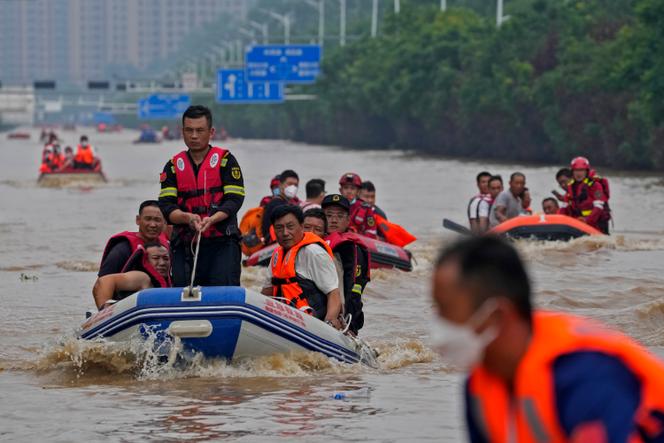


The videographer could hardly believe his eyes on Tuesday morning when he saw the city submerged from the window of his flat. Only the roofs of cars were visible above the brown liquid. The city of Zhuozhou (in the Heibei province) was still shrouded in mist and the rain continued to fall in a strange calm. The water stretched as far as the eye could see and there was not a square meter of tarmac visible. In other videos taken elsewhere in this town some 60 kilometers south of Beijing, one could hear residents call for help, trapped in their homes, sometimes on the roofs of their houses. On Thursday, August 3, three days after the passage of supertyphoon Doksuri, which hit the Philippines and Fujian, in southern China, before it reached the Beijing region, the water had still not receded in the lowland areas south of the Chinese capital.
After devastating the mountainous regions to the west of Beijing, including the Mentougou district, the water continued to flow toward the southern plains. In Zhuozhou, a city of 630,000 inhabitants some 60 kilometers from Beijing, it reached up to six meters. The storms have so far left 21 people dead and 26 missing in Beijing and Hebei, but authorities are playing down the initial toll as usual. Zhuozhou authorities predicted that the water would probably subside within a week in the highest areas but stagnate for more than a month in the basins.
On Wednesday, as residents in the west of the capital began to clear away the mud and debris left by the floods, Beijing's meteorological department reported that the city had suffered the "heaviest rainfall for 140 years." In 40 hours, the city saw the equivalent rainfall of the entire month of July. The "maximum value" of precipitation recorded during this rainy episode at a station in the capital was 744.8 millimeters. The previous record was 609 millimeters in 1891 and the last major floods in Beijing were in 2012, claiming at least 79 lives in the capital.
Prior to the downpour, state media had estimated that around 130 million people would be affected. According to the authorities, some 127,000 people have already been evacuated in Beijing (population 22 million) and 847,400 in Hebei. The rain began to fall in and around Beijing on Saturday and continued until Monday. As early as Saturday, transport was severely disrupted. Hundreds of passengers on a train bound for Beijing had to walk a dozen kilometers before being picked up.
Videos taken in the Mentougou district, west of Beijing, showed streets turned into torrents that swept away even cars in their path. One family saw its house destroyed and its members swept away: The parents were rescued, but their 10-year-old daughter is missing. A bridge crossing a river failed to withstand the current and collapsed taking with it vehicles that were attempting to cross. The rains also caused road sections to collapse, resulting in dangerous gaping holes.
You have 48.8% of this article left to read. The rest is for subscribers only.
